2009-09-28
Classic Sidewalks of the Silver Screen #26
... as the unlucky protagonist of King Vidor's classic silent film, The Crowd (1928), loses something precious to a passing truck.
2009-09-23
Twin Cities Dog Poo Signs #1

up after
your dog
Thank You
[Dog poo sign on tree in Chicago, IL.]

DOGS
(Yes
Your Dog)
[Dog Poo sign in dirt along sidewalk. Location forgotten.]

DO NOT
Dispose of
Dog Feces
In The
Trash
Receptacle
In The Lobby
Management
[Dog poo sign on door of office building. Downtown, Saint Paul.]

After Your
DOG
Being Watched
[And]
You're Being Watched
ITS THE
(Dogs) LAW!
To Pick Up
After Your Dog
[Dog poo signs on subsequent trees. Kent Avenue, Saint Paul.]
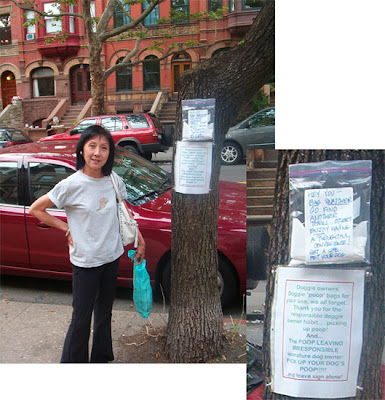 Doggie owners:
Doggie owners:Doggie 'poop' bags for
your use, well all forget.
Thank you for the
responsible doggie
owner habit ... picking
up poop!
And...
The POOP LEAVING
IRRESPONSIBLE
immature dog owners:
PICK UP YOUR DOG'S
POOP!!!!
...and leave sign alone!
[And]
Hey You-
Bag Snatcher
Go Find
Another
Thrill... Others
Enjoy Having
A Thoughtful
Convenience!
Get A Life.
Pet Your Dog.
[Dog poo sign, dog poo bag dispenser, and dog poo sign and bag dispenser maker. Brooklyn, NY.]
2009-09-22
Classic Sidewalks of the Silver Screen #25
... in this General Motors produced piece of propaganda, Give Yourself The Green Light (1954), produced to lobby for the passage of the Eisenhower Insterstate Construction Act. (View the whole thing at the Internet Archive.)
The Case of Bikes V. Cars
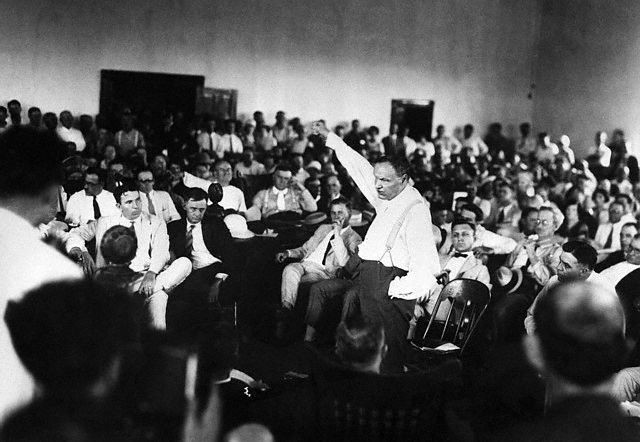 [How old is this debate? Here's a file photo of Clarence Darrow arguing "that bicycles should obeyeth all traffic laws or else suffereth the consequences."]
[How old is this debate? Here's a file photo of Clarence Darrow arguing "that bicycles should obeyeth all traffic laws or else suffereth the consequences."]People on either side of the issue have good arguments. The 'bikes are cars' group, clearly frustrated by unpredictable lawlessness, argues that bikes should obey all traffic laws (just like cars do?), if they want to be treated with equal respect and deference on city streets. Here's an example from Sxoidmal during yesterday's conversation:
It's not an analogy. Bicycles are a part of traffic, regardless of your opinion, and your rationalization will not hold up in court. Take some time to carefully read MN Statutes 169.18, 169.19, and 169.222 to learn what your responsibilities (and rights) are. The fact that cars have the capacity for greater destructive force does not alleviate cyclist responsibility. However, you're right about the trip plates: after hours, when the traffic lights change from timed cycles to weight sensors, this can be a real nuisance for cyclists, and the answer to that is improved cyclist infrastructure. City planners need to be made aware of this legitimate concern.And then there's the other side, represented by JeffK, which is adamant that bicycles are not cars, cannot kill people, and shouldn't be treated the same way.
No. The analogy between bikes and cars is absolutely false, it's tired, it needs to die. Seriously. Your ability to injure another person when you're operating a bike is about a billionth of your ability in a car. This is why 99% of the population will walk across the street without a signal in this situation - because if somehow a car appeared out of the blue, only they can get hurt. Insurance companies, masters of statistics, know this: this is why it's peanuts to buy liability insurance for a motorcycle. Then there's the practical matter of bikes not tripping the sensors in the road to change the light.
I find myself making a similar argument once in a while, whenever (usually older) people complain to me about how cyclists break the laws by rolling through stop signs, etc.
I'm not exaggerating when I say that about half the time, when I stop my bike at a stop sign and wait for a car to go in front of me, they wait for me and wave me through. The other half the time they drive through in front of me after an extra-long pause.
My personal rules about cycling in the T.C. are something like this:
- Stop at every stoplight. Proceed through red lights only if there are no cars even close to the intersection.
- Slow down before each stop sign. If there are no cars at the intersection, roll through (sometimes rather quickly). If there are cars, defer to them.
- (When biking on a busy street, proceed with absolute caution and nervous anxiety at all times, especially at intersections, knowing that at any minute one could be severely injured by a driver talking on a cell phone and speeding around a corner.)
I developed this through a process of trial and error (and a number of close calls), seeing what works and what is expected of cyclists around town. Most of my friends have rules that are very similar to this. I might know maybe one person who always waits at every stoplight, no matter how deserted it may be, but I doubt it.
But the problem is that the rules here are so different from what is 'officially' expected of bicycles as they go around town. As Tom Vanderbilt points out in his book, the actual rules of traffic are something that emerges socially from the daily interactions of people sharing space on the street. We take it as a given that cars can go 5 - 10 mph over the speed limit on highways, even though that's technically illegal. (That number is quite a bit higher on the East Coast.) It's common practice to speed up to catch a yellow light, even though that is technically illegal. It should be (and sometimes is) illegal to text or mess with a cell phone while driving (or apply makeup or eat a complicated sandwich or tie your shoes, etc.), but people do this all the time. Jaywalking is illegal, but unenforceable and unenforced. Perhaps bike laws (such as the ones suggested by Mpls legislator Phyllis Kahn) that are more in line with how both bicycles and auto drivers actually behave, may be a good idea.
Twin Cities' streets are not designed to treat bicycles and cars equally. Streets are almost universally designed to make life easy for motorists, while bike infrastructure is about as rare as a Minnesota roundabout.
I was reading a study about different approaches to making cycling safer in US cities, and there are a lot of things that cities can do to create safe conditions for cyclists. The list includes bike-focused streets, separated bike lanes, "bike boxes" at the front of intersections, and special traffic signals for cyclists. The report quotes a study, that showed that, once a separate "scramble" signal for cyclists was installed at a stoplight intersection in Portland, cyclists started obeying the traffic laws in very high numbers.
The results indicated that the volume of cyclists using the intersection increased and the amount of illegal crossings significantly decreased after the scramble signal was installed. Specifically, 78.1% of all cyclists passing the intersection before the signal change did so illegally, while after the signal was installed, only 4.2% of cyclists made an illegal crossing.[p. 6 of "Intersection Treatments to Improve Bicycle Access and Safety", Portland State U's Center for Urban Studies.]
That's a pretty big change. The current problem, and one of the reasons that the Small Laws blogger will have no shortage of material, is that Twin Cities' bicycling laws and infrastructure are out of whack with how both cyclists and car drivers expect each other to behave. The new bike boulevard in Saint Paul and the new bike boxes in Downtown Minneapolis are good starts toward bringing actual cycling behavior more in line with the ideal world of transportation planners and lawmakers.
Meanwhile, I'm going to keep riding through deserted stop signs, having awkward moments interacting with cars in the neighborhood, and occasionally having near-death experiences as giant red Chevy Suburbans turn onto Lexington right in front of me while I'm in my bike lane on Como Avenue until I scream at them twice and they finally stop before running over my leg and ruining my only means of transportation.
2009-09-21
Name That Sidewalk! #3
I saw this crazy car on the sidewalk one day, absolutely stacked to the ceiling with paper...
... the only question is: Where in the Twin Cities is this sidewalk?
The winner receives a prized copy of Clyde Fans: part one, a graphic novel-type publication featuring wonderful antiquated urban landscapes and typewriters, drawn and written by Seth Weeks of Montreal Canada.

2009-09-18
*** Sidewalk Weekend *** #34
 Sidewalk Rating: Indian summer
Sidewalk Rating: Indian summerOK, this is the last weekend of summer, the end of the halcyon spree. This is it. I promise. I'm headed to Chicago, and have been biking around town despite the humidity, through the gangs of campus'd undergrads.
In case you haven't seen this awesome music video...
WHERE WE'RE FROM
... giving mad props to Saint Paul, my hometown. (Via EastLake.)
Apparently this blog is tied at #70 on the list of "Top 100 Minnesota Blogs". While I'm sure that this list is on logarithmic scale, nobody is more surprised than I am.
I found a new blog that claims that sidewalks were first created in 18th century London.
In a way, that might be true. Sidewalks, per se, arrive about the same time as rapid transportation that is moving fast enough to kill pedestrians (in this case, horse-drawn carriages, which frequently struck and killed 18th c. Londoners). On the other hand, there were sidewalks, of sorts, in places like Pompeii, used primarily to allow people to walk down the street without stepping in puddles of shit and piss.

The aforementioned Wisconsin state house member who was the driver in this terrible accident in Madison, WI was fined $88 for his negligence.
Seems rather low to me? Why do you get a larger fine for blocking a snow emergency route, than for running a red light and T-boning a cyclist head-on in the middle of the day?
There's a new non-profit that's going to form co-ops for subsidized taxi rides in California. I doubt it will make money, but the idea is a lot like MetroTransit's 'Guaranteed Ride Home' program, which grants me about $100 worth of free cab rides each year. Needless to say, I love this program. It's little things like this that allow one to go without a car. Most of the time you don't really need one, but in those rare cases that you really want a car, a subsidized taxi cab comes in really handy.
Here's a new blog post (and very long comment thread) about how freeways built through the middles of cities caused, on average, an 18% decline in that city's population (as people moved into the suburbs). That's one of the reasons why I don't understand why city governments (Minneapolis, Saint Paul) still go out of their way to encourage the fast (highway-like) movement of cars through the city. (See Minneapolis's one-way street pairings.)
I read somewhere a little bit ago about how the post-industrial economy changes the dynamics of local politics as businesses become more and more centralized in the few global cities (NYC, LA) leaving middle-sized cities dependent on local banks, developers, and construction compaines. This kind of thing reinforces the way that cities become dependent on sprawl, development, growth, and big ticket construction projects, which, unsurprisingly, then become the focus of local governments and business lobbying. Well, it turns out that Minneapolis is somewhere in the middle of the pack when it comes to having its local economy dependent on housing construction and real estate development.

(I should add that this seems like a wasteful thing to have at the heart of your national or local economy, which literally becomes something like a house of cards.)
Three photos for you!
1) The beauty of a Minnesota parking lot in a screenshot from the movie Fargo. (Img. fm. Sutpen.)
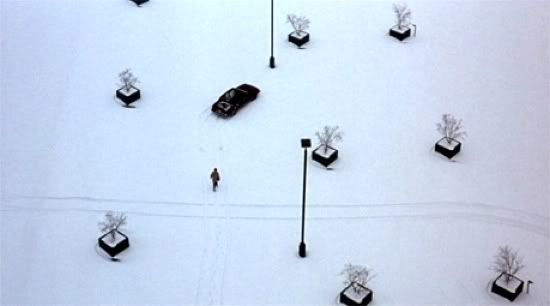
2) Awesome LRT heatlamp button modification. (Img. via Metblogs.)
 3) I've been spending all my days at the Minneapolis Central Library, looking out the window at the former site of Gateway Park while I study. (Img via Lileks.)
3) I've been spending all my days at the Minneapolis Central Library, looking out the window at the former site of Gateway Park while I study. (Img via Lileks.)
2009-09-17
Sidewalk of the Week: Grand Avenue S and 36th Street
I’ve long had a thing for laundromats. The smell of detergent, the white noise of the machines, the carts that don’t quite go in a straight line, the large clothes folding tables, the constant din of Court TV, and especially the odd mixture of cleanliness and squalor. A good laundromat combines public and private in very unusual ways. You walk in with things seldom seen, underwear and bedsheets and towels, and after a quick scan of the rows and rows of identical machines, you stake your claim. Confidently, you stride: “These three washing machines are mine.” “I’m going to take this chair, this cart, this folding table.” All of a sudden, you have a little home away from home. You are alone, yet surrounded by other people. Everyone is hard at work, all glancing, all avoiding eye contact.
[The corner harbors a bus stop, and a couple of two-story mixed-use buildings.]
[The sidewalk is well-lined with trees, benches, tables, bikes, newspaper boxes, pop machines, bus stops, lampposts, sandwich signs, windows, and parked cars.]
You throw your laundry into the machine. Then what? What do you do while you wait? Well, I’ve been to a lot of Laundromats in the Twin cities, and my all-time favorite Minneapolis machines are on this week’s Sidewalk of the Week: Grand Avenue South and 36th Street.
 [Some of the sidewalk furniture along 36th and Grand.]
[Some of the sidewalk furniture along 36th and Grand.]
This Laundromat is perfectly embedded into its sidewalk, part of a little corner in the middle of the Kingfield/Calhoun neighborhood. South Minneapolis is full of these little mixed-use commercial spots, but this has to be one of the smallest, most intimate commercial corners in the city. It’s nothing but a few buildings: a laundromat, a new-age book and herb store, a little house and storefront place that sells some sort of audio services, and a nice coffee shop and bakery with outdoor seating. That’s it, but it does wonders to increase the convenience and character of the surrounding homes. I’ve had such wonderful afternoons hanging out on this corner after my laundry has been put into the machine.
You can go down to the coffee shop, admire the awesome mural, eat the good food, and hang out on the sidewalk. You can browse the strange bookstore, where I usually find a good paperback for $1, and where I once entered to find the cashier sitting cross-legged on top of the display counter. You can watch people walking by. I remember once I was hanging out on the little bench in the window of the laundromat next to the open corner door, and ended up listening for 15 minutes to someone practice a saxophone from one of the windows of the nearby homes. The intimacy of this sidewalk has everything to do with the small size of the node and the low levels of car traffic. Almost effortlessly, you can hang out on these streets, stroll a few blocks to Lyndale or Nicollet, and not get bored.
If only every neighborhood had so simple a commercial node, just a few buildings every quarter mile or so, to give people somewhere to walk to and from. But, mixed-use property like the little clump at 36th and Grand is illegal in almost all suburban areas. In order to get a cup of coffee, you have to drive quite a ways to the giant commercial complex along the highway. During the bygone era of laundromats, you probably walked or pushed a cart from your house. The older parts of the Twin Cities are dotted with littlelaundromat corners like this one. My favorites have large windows opening onto the sidewalks, and come with corner stores or coffee shops, but they’re all over the place.
[The laundromat opens directly onto the sidewalk corner, inviting people in or out, perforating the businesses and wafting laundromat scents throughout the neighborhood.]
[There are lot of places you can walk from this corner, in the heart of South Minneapolis.]
There’s something wonderful, though, about this little corner on Grand Avenue, one of the only places I can think of that has an outdoor pop machine along the sidewalk. You can grab a can before you realize that your laundry is probably done by now, and you head back into the little room to fold the clothes by a window along the street, making shirts into little squares while daydreaming to the spinning humming dryers. Here’s to you, little Laundromat corner! May all your clothes come out clean.
2009-09-15
James Howard Kunstler Thinks Downtown Minneapolis Blows
 [A woman trapped inside the downtown skyway system, longing to escape onto the streets of Minneapolis.]
[A woman trapped inside the downtown skyway system, longing to escape onto the streets of Minneapolis.]I was catching up on my backdated listening for the KunstlerCast podcast, one of my most guilty pleasures, and I came across this wonderful James Howard Kunstler (#12 All-Time Urban Thinker) mini-rant about a visit to downtown Minneapolis.
Let me know what you think. I've been meaning for some time to write more about my thoughts on Twin Cities' skyway system. If I was smart, I would tackle this issue during the summer months, instead of waiting until the dead of winter. Once you build them, they're awfully hard to get rid of... so it seems like we'll just have to live with these skyways come hell or high water.
At any rate, I find myself, as usual, agreeing with Mr. Kunstler's opinions.
2009-09-13
2009-09-11
Fixing the Sidewalks

 A while back these little white arrows started appearing on the sidewalks in Northeast Minneapolis. Little arrows on the concrete, little dots of white paint appearing every once in a while as you walked down the block.
A while back these little white arrows started appearing on the sidewalks in Northeast Minneapolis. Little arrows on the concrete, little dots of white paint appearing every once in a while as you walked down the block.These kinds of markings often crop up on the streets, some sort of mysterious code, engineering graffiti, colorful kinds of signs turning the streets into a hierogryphic palimpsest. But you rarely, almost never, see these markings on the sidewalks. Sidewalks are for chalk and hopscotch...
Then, one morning I awoke to the loudest cacophony of jackhammers and diesel and truck-backing-up-beeping and the sidewalks were gone! They'd been sawed at and chopped up and hauled away and holes appeared. You could see the sandy beach beneath the streets, the dirt and tree roots that form the real foundation for our footsteps.
The workers worked quickly, digging up and pouring concrete. It only took them a day or two to finish the few blocks that I watched.

I can't actually find the section in the Minneapolis City Code where they talk about how large a gap there can officially be between the paving blocks. Officially, I remember reading once that the city has to keep sidewalks level to a certain degree, and every once in a while they obviously go around measuring the cracks in concrerte, and then fixing them.
I'm not sure what the assessment is, but I'm sure its expensive. Despite my concern for sidewalks, I don't actually care that much about what they actually look like. Whether or not a sidewalk is good or bad, or worth walking on, has little to do with what sort of material it is. The sidewalks of Prague are some of the best in the world, but their cobblestones are terrible for walking (or so I've heard). In my opinion, apart from disability access, there's little reason to go around spending fixing sidewalks may have risen 3/4 of an inch.
Anyway, It's interesting to see sidewalks being poured. I resisted the urge to place my hand or write my name in the wet concrete.
2009-09-08
Reading the Highland Villager #5 (September 2 - 22 Edition)
 [[This edition was chock-a-block full of election coverage, descriptions of various School Board and mayoral candidates. Thus, less sidewalk news. -Ed.] Basically, the problem is that the best source of local streets & sidewalks news in Saint Paul is the Highland Villager. This wouldn't be a problem, except that its not available online. I'm reading the Highland Villager so that you don't have to. Until this newspaper goes online, sidewalk information must be set free.]
[[This edition was chock-a-block full of election coverage, descriptions of various School Board and mayoral candidates. Thus, less sidewalk news. -Ed.] Basically, the problem is that the best source of local streets & sidewalks news in Saint Paul is the Highland Villager. This wouldn't be a problem, except that its not available online. I'm reading the Highland Villager so that you don't have to. Until this newspaper goes online, sidewalk information must be set free.]Total # of articles about sidewalks: 4
Total # of articles about sidewalks written by Jane McClure: 4
Title: City offers to underwrite additional LRT station
Author: Jane McClure
Short short version: Villager version of the well-covered story about the added LRT station along University Avenue. Story goes into some detail about the bureaucratic detail, including the Management Committee vote on the city offer and that the Final EIS allowed for the station to be added in an expedient way. Includes an amusing Mayor Coleman quote about how "there never any question that there'd be at least one infill station." [Yeah, right. -Ed.] The money for the station is going to some from random TIF districts from along the LRT line. The County and Rail authority still need to see how this will impact ridership estimates.
Title: Board rejects variances for Pride's project
Author: Jane McClure
Short short version: StP Board of Zoning Appeals (BZA) voted to reject a request or variance to build an apartment building for low-income people along W. 7th Street. The current zoning code requires new buildings to have at least a 2 acre site, and parking lot with at least 25 feet setback, while the proposed site has only 1.23 acres and 4-foot parking setback. The denial came against the BZA city staff recommendation, and there is some accusations that the city is just putting up political resistance to building low-income housing [which is never, ever popular. -Ed.]. Article has lots of quotes about how the decisions screws the Project for Pride in Living (PPL), who were trying to build the apartment building.
Title: Proposal gives St. Paul's chicken owners something to cluck about
Author: Jane McClure
Short short version: Council Member Russ Stark is trying to relax reualgions for city chicken permits. Currently you have to get 75 % of your neighbors to agree to share their neighborhood with chickens, and pay a $72 annual fee. Stark wants to get rid of the petition requirement and lower the fee to $25 (as long as you have fewer than 3 chickens). The city has been studying urban chickenry for some time.
Title: SUPC supports plans for a Subway restaurant on Selby-Victoria corner
Author: Jane McClure
Short short version: Summit-University Neighborhood Council supports the attempt to build a subway franchise on Selby & Victoria. [A long-underinvested corner. -Ed.] It will need a Conditional Use Permit, and may require other variances. Story has some debate about the health merits of fast food
2009-09-04
*** Sidewalk (Long) Weekend *** #33
 Sidewalk Rating: Still Summertime
Sidewalk Rating: Still SummertimeIt's still summer, dammit. You had better make the most of the sidewalks this weekend, or I'll never speak to you again.
Here's an example of what we can look forward to...
... if we're lucky!
Carlos Slim, in addition to having an awesome name and being the world's richest man, is a bona fide urbanist!
"More recently, Mexico's richest businessman, Carlos Slim, established a private initiative known as the Fundacion del Centro Historico into which he initially invested $300-million and developed a long term regeneration plan for the city centre. The Fundacion initially bought 70 historic buildings and set about a major refurbishment programme to turn them generally into middle to high income residential.
"Then he brought the city government into the act in upgrading the infrastructure - pavements, beautiful period lampposts, et cetera, as well as providing a new Centro police force complete with CCTV system and relocating all the informal traders - they are now banned from El Centro!
"The result is a highly walkable public environment among some truly beautifully restored historic buildings. The refurbed residential has in turn attracted new restaurants and high quality retail."
This NYT story confirms what I saw when I went to Florida last summer: lots of half-built and empty condo towers. Apparently, people have stopped believing in paradise.

Awesome signs that don't tell you very much, archived on a website. Have you met my friend, Les Ismore?
One of the reasons Cambridge, Mass. is so nice is that they get rid of signs like this. It's a trend, man.
I went through a Mad Men phase, and am happy to see that they're covering the destruction of Penn Station as a mini-narrative this season.
Jane Jacobs was right!
I hope Madison, Wisc. can make the right decision about their train station. It's a battle of common sense v. bureaucratic expediency. Knowing Wisconsin, neither of these will win out in the end.
Speaking of Wisconsin...
As a cyclist, I absolutely hate watching that.
Beware the primrose path of dalliance, lest ye find yourself wearing Denny Hecker's auctioned shoes!
(I think you're best avoiding any company who advertises during Twins games.)
As if I didn't feel bad for Duluth already, now their sidewalks are crumbling beneath their feet.
Sous le pavés, le plage!
(And again.)
Three photos for you!
1) Abandoned cityscape & prairie restoration. (Fm. James D. Griffioen)
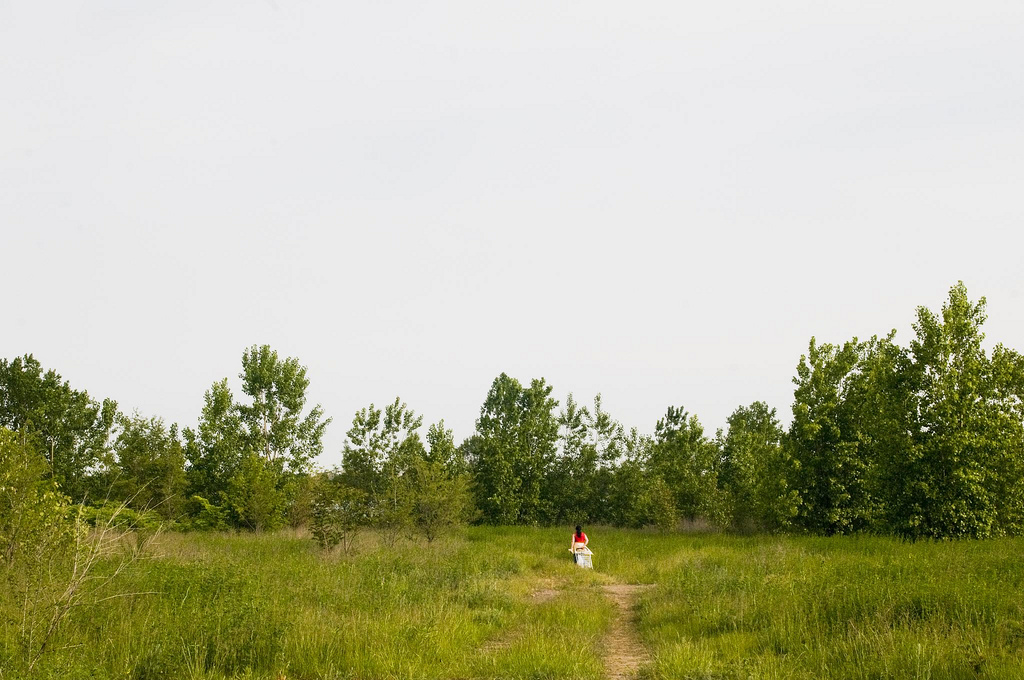 2) State fair bandshell. (Img. fm. Minnpics.)
2) State fair bandshell. (Img. fm. Minnpics.)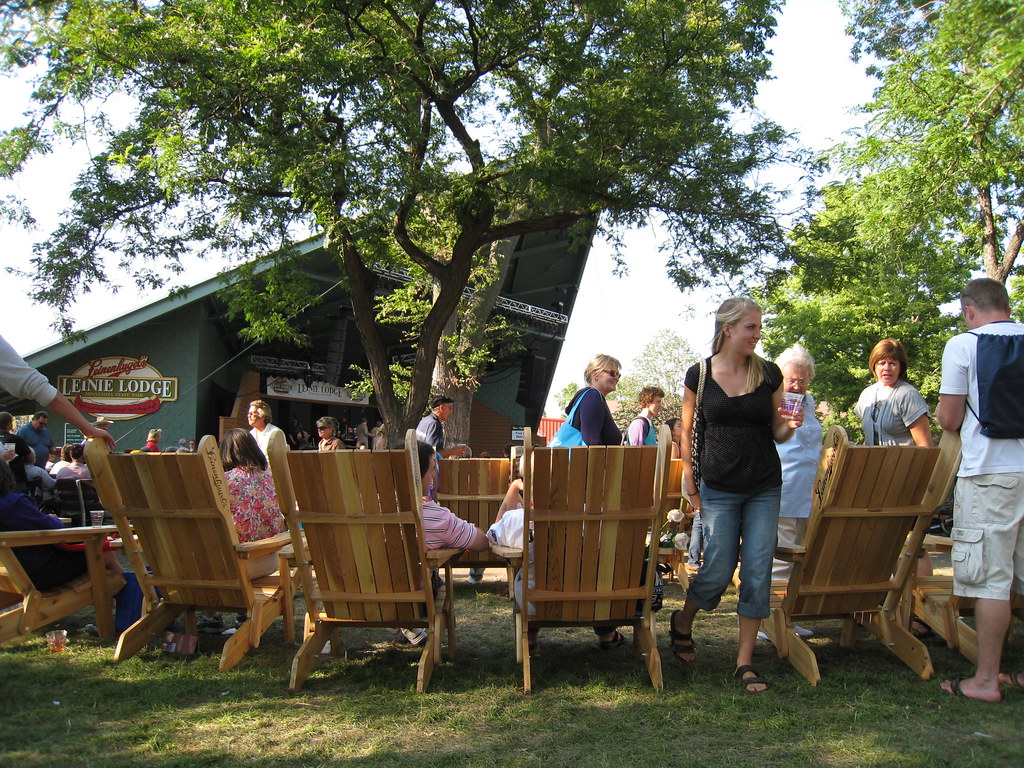
3) A nice look at the Walker sidewalk. (Img. fm. Robert.)

2009-09-03
Classic Sidewalks of the Silver Screen #23
... in Godard's 1960 classic, A Bout de Souffle (Breathless).

























